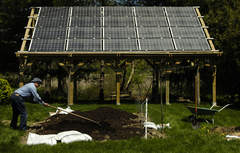Rich Herr works compost material into his backyard garden as his recently-built solar energy array looms in the background at his home in Valparaiso Wednesday May 8, 2013. Herr, 74, says the 20 panels are capable of generating up to 5000 kilowats per hour. | Andy Lavalley~Sun-Times Media
Click HERE to see more photos> http://posttrib.suntimes.com/photos/galleries/index.html?story=19987416
To learn more about the voluntary reporting of solar PV systems in Indiana see:
https://openpv.nrel.gov/search?state=IN&zipcode=
The NREL Open PV website now lists 310 solar PV systems installed in Indiana with a total capacity of 4.42 MWs. This number is expected to skyrocket to nearly 100 MWs as the approved projects using both the NIPSCO voluntary feed-in tariff (VFIT) and a similar program offered by Indianapolis Power and Light (IPL) called Rate REP --if the owners and/or developers register their projects on this website.
Please help us to get all solar PV projects installed in Indiana to register with the NREL Open PV project. If you know of a project in your area that is not listed, please let us know and let's work together to get it listed.
By the way, wouldn't it be great if we had a similar website that reported other renewable energy and distributed generation projects in Indiana? We need similar data for solar thermal, small wind and biomass projects. Will you help us to create such a database? If you want to help, please contact me at Laura.Arnold@IndianaDG.net or call (317) 635-1701.
Valpo man builds solar system for home
By Matt Mikus mmikus@post-trib.com
May 14, 2013 4:22PM
VALPARAISO — With costs dropping on solar power cells, Rich Herr, a retired electrical engineer from Valparaiso, decided to build his own solar power system in his backyard.
Working with a few friends, Herr, 74, built the frame and installed the cells, bringing the system on the grid in January. He estimates that the project cost about $13,000, not including the work he and his friends put into it.
“It helps to have friends,” he said.
Herr also sits on the board of an alternative energy company, Earth Solar Technologies in Indianapolis.
With 20 solar panels, Herr averages about 20 kilowatt hours a day, some days topping off at over 25 kilowatt hours a day, or about 600 a month. The average household uses about 940 kilowatt hours a month, according to U.S. Energy Information Administration.
Using a net-meter, Herr’s solar array feeds energy to the electric grid during the day, subtracting the amount of energy from the amount he uses at night and on cloudy days.
He estimates his savings on energy is a better return than his retirement plan.
“For the money I put in it,” he said, “the return on it is better than the return I get on my 401(k). I’m not getting money in my hand, that’s just money I don’t have to pay.”
Herr’s not the only one walking on sunshine. According to the National Reusable Energy Laboratory, at least 300 businesses or residences in Indiana are using solar energy.
There are probably more because the data collected by the NREL is voluntary.
“Once somebody starts it, and the neighbors see an average person can do it, it catches on like wildfire,” said Laura Arnold of Indiana Renewable Energy Association.
Out of 112 customers that are tapped into Northern Indiana Public Service Co.’s alternative energy program, 26 solar power systems in Lake and Porter counties are registered. Fourteen of those run on a feed-in tariff, which pays back customers for each kilowatt hour generated, depending on the source of energy. The other 12 are on net metering.
“It tends to be that those on the net metering are primarily residential,” said Nick Meyer, a spokesman for NIPSCO. Eight of the solar customers are residents using net metering, while only five solar projects for homes are on feed-in tariffs.
The pilot three-year alternative energy program is reaching its end, Meyer said. After the final year is up, NIPSCO will consider the future of the program, but those with renewable generators will still continue operations.
Barriers to going solar
But while the average cost to provide solar energy continues to decrease, barriers to fast adaptation remain.
“It’s often the initial cost,” Herr said, “and utilities have been dragging their feet to make this stuff user-friendly.”
Herr has the fortunate knowledge of an electrical engineer, and resources from being on a company board. Others may need to hire contractors and companies to plan the system, adding to the up-front costs.
And there’s the need to have a south-facing roof at the right pitch with enough support for the panels, or enough space to set up
Before considering installing a solar panel, Arnold said it’s important to reduce the amount of energy consumed by the household. Otherwise, you’ll pay a higher starting cost.
“The cheapest energy system is to not need the energy in the first place,” she said. “You don’t want to put a solar system on an energy sieve.”
Herr remodeled his house in 2001 and planned for updating the insulation. He was able to add 700 square feet to his home without increasing his costs for heating.
He learned two years later about passive homes, designed to take advantage of natural heating and cooling, without the use of air conditioning and furnaces. Since then, he’s become a strong advocate for designing homes with more efficient heating.
“There’s a lot being done, but you don’t see it in building codes. I think that’s a big mistake,” Herr said. “It’s new and different, so it’s difficult to accept. Builders want to make sure there aren’t any major problems.”
“But I think it’s coming,” he added, “because we can’t afford to keep spending the cost for energy and fuel.”



